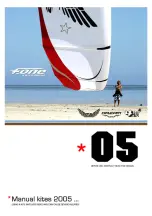
13
to –3 or –4 m/s and reduces the ground speed by 3 to 5 km/h. The angle
of attack and effective wing-loading will also increase due to the smaller
surface area of the wing.
To activate the ‘Big ears’ manoeuvre, take the outer ‘3 A 3’ line on each
A-riser and simultaneously, smoothly pull them outward and downward.
The wingtips will fold in. To release the ears, let go of the lines and
the tips should return to their normal position. If they do not re-inflate,
gently pull on one of the brake lines and then on the opposite one. We
recommend inflating the wing tips asymmetrically, without major change
to the angle of attack, especially when flying near the ground or flying in
turbulence.
Ears can be used with the trimmers in any setting.
5.2 B-LINE STALL
During this manoeuvre, the wing ceases to fly, it has no horizontal speed
and the pilot has no control over the paraglider.
The airflow over the profile is interrupted and the wing enters a situation
similar to a parachutal stall.
To enter this manoeuvre, the ‘B’ risers are grabbed below the maillons and
symmetrically pulled down together (approx. 20-30 cm) and then held to
this position.
The initial phase is quite physical (high pull resistance) requiring a strong
tug until the wing’s profile/chord deforms. The initial pulling force will then
be significantly lessened. Holding the ‘B’ lines in the pulled down position
will be necessary to maintain the configuration.
The wing will then deform, its horizontal speed will drop to 0 km/h, vertical
descending speed increase to –6 to –8 m/s depending on the conditions
and how the manoeuvre was performed.
To exit the manoeuvre, simultaneously release both risers. The wing will
then slightly surge forward and automatically return to normal flight. It is
better to let go of the lines quickly rather than slowly.
This is an easy escape manoeuvre to do, but remember that the wing will
stop flying, will lose all forward horizontal speed, and its reactions will
change significantly when compared to normal flight configuration.
5.3 SPIRAL DIVE
This is a more effective way to rapidly lose altitude. Beware that the wing
will experience and be subjected to a tremendous amount of descending
and rotating speed (g-force), which can cause a loss of orientation and
consciousness (blackout). This manoeuvre must therefore be done
gradually to increase one’s capacity to resist the g-force exerted on
the body. With practise, a pilot will fully appreciate and understand it.
Only practise this manoeuvre at high altitude and with enough ground
clearance.
To start the manoeuvre, first weight shift and pull the brake handle
located on the inner side of the turn. The intensity of the turn can be
controlled by braking slightly using the outer brake handle.
A paraglider flying at its maximum rotating speed can reach –20 m/s, or
the equivalent of a 70 km/h vertical descent, and will stabilise in a spiral
dive from 15 m/s onwards. Good enough reasons to familiarise yourself
with the manoeuvre and understand how to exit it.
To exit this manoeuvre, the inner brake handle (down side of the turn)
must progressively be relaxed while momentarily applying tension to the
outer brake handle opposite to the turn. The pilot must also weight shift
and lean towards the opposite side of the turn at the same time.
The exit should be performed gradually and smoothly so that the
changes in pressure and speed can be noted.
When exiting the spiral, the glider will briefly experience an asymmetrical
Summary of Contents for BI SKIN 2 P
Page 1: ...USER S MANUAL BI SKIN 2 P...
Page 19: ...19 10 3 RISERS PLAN...








































